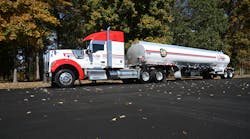CONFUSED by the Hours of Service changes that went into effect on July 1? You’re not alone.
The new regulations are a bit vexing, but Jeff Langloss, program manager for the Federal Motor Carrier Safety Administration’s (FMCSA) office in Austin, Texas, made an appearance at NTTC’s Tank Truck Week October 28-30, 2013 in Houston, Texas, to offer enlightenment and clarification.
The two most confusing aspects:
• 30-minute rest break.
“It was written by lawyers, and some people find it totally confusing. Basically, the rule says: Thou shalt not drive if you have not had a 30-minute break in the last eight hours. So if your driver is planning for 14-hour days, of course only 11 of that is driving. When does a driver take his break? Sometime between the sixth and eighth hour. Then he’ll only have to take one break. If he takes it in the fourth hour, he will have to take two breaks. So it’s more of a logistical thing of thinking how long a driver’s scheduled to drive.
“Does it include on-duty not driving time? Yeah. If your driver comes to work for nine hours and you dispatch him out to drive across town, he has to take 30-minute break before he takes a load across town.
“We do have an explosives exception: If you’re transferring any hazardous material, 49 CFR Part 397 requires you to be in attendance of the vehicle at all times while it is parked. You’re allowed to take a break as long as the only thing you’re doing is attending the vehicle.”
• 34-hour restart.
“I can’t tell you how many phone calls we get every day at our office, asking, ‘How do I fit in the 34-hour restart? My drivers only work six days a week and work eight hours a day.’ My question back is, ‘Why are you trying to get a 34-hour restart?’ You’re not required to. You can have somebody work 8¾ hours every day of the year, 365 days a year, and you will never be in violation.
“If you choose to take the restart—and that’s what it is: a choice—to help you reset your clock, you have to meet two criteria: (1) you must have at least 34 consecutive hours off duty; and (2) there must be two rest periods of 1 am to 5 am within that 34-hour restart. You have to start at 7 pm on Friday and restart at 5 am on Sunday—that’s 34 hours. You can now do this only once every 168 hours--that’s seven days. It starts at the beginning of a 34-hour restart. So I can start the next 34 hours at 7 pm the next Friday.
“But let’s say I decide to start my break Thursday at noon. And I’m off until Monday. Do I get a restart? Yes. But does the 168 hours start on Thursday or Friday? It starts Friday at 7 pm. You don’t get credit for that extra time taken off Thursday. But as long as you had 34 hours off after the 168th hour and two periods of 1 am to 5 am, it does count as a restart.”
Speaking about the Driver Vehicle Inspection Report (DVIR), he said the eight most common violations in roadside inspections all appear on pre-trip or post-trip DVIRs. The most common violations are brake problems, windshields, tires, and emergency equipment. He said 4%-5% of all roadside inspection violations are related to emergency equipment.
“Seventy-five percent of those violations are things that could have been caught by the DVIR,” he said. “I will give you kudos. You guys are doing a better job than the rest of the trucking industry.
“One thing I’ve learned over the years is that every violation counts. So every emergency equipment factor—every fire extinguisher that is not secure, every tire that is a little bit low—counts on the CSA score.
“I’m trying to get drivers to do a better daily vehicle inspection report. People ask, ‘How can I do that? I don’t see my drivers.’ How many of you--every time your driver has a roadside inspection and it’s sent to the company-- have somebody compare it to the last few days’ DVIRs? Because if your driver gets cited for a tire with less than 2/32” of tread, did that happen overnight? He should have caught it before the officer did. You can catch some of the real easy ones.”
Langloss said that in Texas today, there are still over 250,000 drivers who have not contacted DMV and gotten their medical card connected to the CVR.
“Any driver that has not done that in any state, because of federal law, is going to have his license suspended,” he said. “How many of you are helping drivers with this process? Think about this: It’s going to affect you because they will no longer have a CDL come the end of January. In Texas, if a license gets suspended, the driver will have to retake the written test and vehicle inspection because he has voluntarily surrendered his license. Some states require that, some don’t.
“You can go online, in person, by email, or by fax. The best way, according to DMV, is by email or online because it’s the quickest and fastest. You get a receipt back immediately by confirmation email.
“A medical card is good for two years. A Texas commercial driver license is good for five years. So what’s going to happen when the two-year medical card expires? You have to get a new one or your CDL is going to expire. You still have a regular operator’s license. You have to re-file before the medical card expires. So in two years, you get a new medical card on file, and that’s good for another two years, and you have a CDL for another two years. At the end of that, your do it again, but now your medical card runs longer than the license because the license is going to expire in a year. When you go to renew the license, your medical card will move over to your new license. You will not have to get a medical card in another year.” ♦








